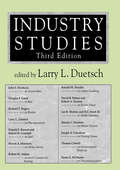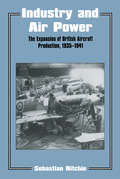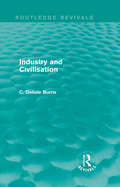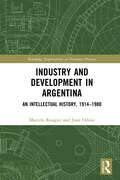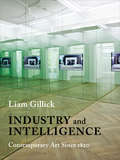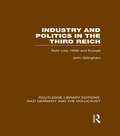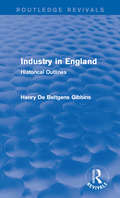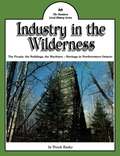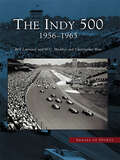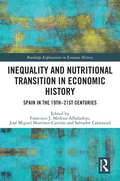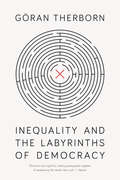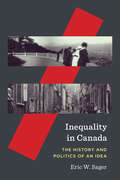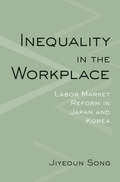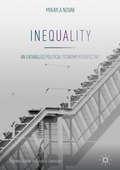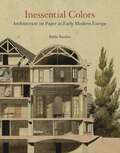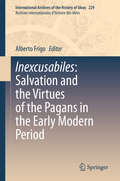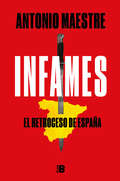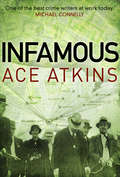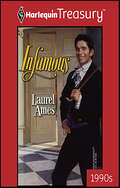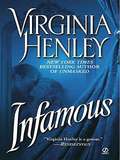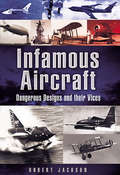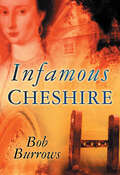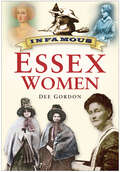- Table View
- List View
Industry Studies
by Larry L. DuetschFeaturing new chapters on casino gambling and the nursing home industry, and updated throughout, the new edition of this highly readable text analyzes well-defined industries from commodities and manufacturing to distribution and services, showing how firms compete with one another. Each study gives appropriate attention to government policies that have influenced competitive conditions in the industry, and the material is presented without the use of calculus so that anyone with some background in economic principles can benefit from it. The book provides balance in regard to the mix of industries dealt with, and also in the varying perspectives of the contributors.
Industry and Air Power: The Expansion of British Aircraft Production, 1935-1941 (Studies in Air Power #Vol. 5)
by Sebastian Ritchie Noel Sebastian RitchieThe author begins with a general survey of British aircraft manufacturing in the inter-war period. Policy, production, finance and contracts are examined, and the final chapter is concerned with the mobilization of the aircraft industry in 1939, and the emergency measures of 1940.
Industry and Civilisation (Routledge Revivals)
by C. Delisle BurnsOriginally published in 1925, Industry and Civilisation explores moral standards and ethics related to economic activities by providing a comprehensive view of psychological data obtained from the business world. As well as exploring general ethics and psychology, this work also focusses on the principles underlying economic legislation and how this impacted on moral standards of the time. This title will be of interest to students of Business and Economics.
Industry and Development in Argentina: An Intellectual History, 1914–1980 (Routledge Explorations in Economic History)
by Marcelo Rougier Juan OdisioThis book explores the twists and turns in Argentina’s modern economic history and the debates that raged there around a problem common to all former colonies: how to achieve a level of economic growth for its population in a world characterized by unequal economic relations between the industrialized nations of the north and the commodity producers of the south. This new perspective examines the history of ideas surrounding industrialization and economic development in Argentina, drawing on a rigorous investigation of multiple sources. It demonstrates Argentina’s role as a laboratory for and disseminator of ideas that would eventually become the common property of all the developing world. Influential thinkers such as Raúl Prebisch and Aldo Ferrer, leading figures in twentieth century Latin American economic thought, developed important ideas such as unequal international trade relations, the promise and limits of Import Substitution Industrialization, the role of the state in the development of a national capitalism. These were the forerunners of similar concerns in other countries in Latin America and elsewhere in the world. The book will be of interest to historians, economists, sociologists of economic development, and related disciplines concerned with questions of global economic inequality.
Industry and Intelligence: Contemporary Art Since 1820 (Bampton Lectures in America)
by Liam GillickThe history of modern art is often told through aesthetic breakthroughs that sync well with cultural and political change. From Courbet to Picasso, from Malevich to Warhol, it is accepted that art tracks the disruptions of industrialization, fascism, revolution, and war. Yet filtering the history of modern art only through catastrophic events cannot account for the subtle developments that lead to the profound confusion at the heart of contemporary art.In Industry and Intelligence, the artist Liam Gillick writes a nuanced genealogy to help us appreciate contemporary art's engagement with history even when it seems apathetic or blind to current events. Taking a broad view of artistic creation from 1820 to today, Gillick follows the response of artists to incremental developments in science, politics, and technology. The great innovations and dislocations of the nineteenth and twentieth centuries have their place in this timeline, but their traces are alternately amplified and diminished as Gillick moves through artistic reactions to liberalism, mass manufacturing, psychology, nuclear physics, automobiles, and a host of other advances. He intimately ties the origins of contemporary art to the social and technological adjustments of modern life, which artists struggled to incorporate truthfully into their works.
Industry and Politics in the Third Reich: Ruhr Coal, Hitler and Europe (Routledge Library Editions: Nazi Germany and the Holocaust)
by John GillinghamWhen originally published in 1985 this was the first detailed study of business in Nazi Germany. Drawing on a wealth of new evidence from government and private archives, the book throws light on the important role played by Germany heavy industry in preserving traditions valuable for the post-Nazi future. Contrary to widely held beliefs, the industrialists of the Ruhr did not master-mind the economic strategy of the third Reich, nor were they the helpless victims of Hitler’s tyranny. In this penetrating study, the author reveals that while the management of the coal industry in the Ruhr certainly cooperated with Hitler, they did so only to the extent that it served their own purposes, which were far less destructive than those of the regime.
Industry in England: Historical Outlines (Routledge Revivals)
by Henry De GibbinsOriginally published in 1912, Industry in England provides a complete history of industry and industrial changes in England from pre-roman times to modern England as it stood in the early twentieth century. Using Gibbons’ previous text The Industrial History of England as a base, this work aims to tackle economic and industrial questions in relation to social, political and military contexts in further detail to present a full picture of what life in England was like at the time these industrial changes took place and how this influenced industry. This title will be of interest to students of History.
Industry in the Wilderness: The People, the Buildings, the Machines — Heritage in Northwestern Ontario
by Joan MageeFilled with photographs, both historic and contemporary, this engaging book looks at the industrial pioneers of northwestern Ontario, and the activities which brought them to the wilderness: surveying, railroading, lumber, gold, bush piloting, transportation, and hydro power. Rasky lets the pioneers tell their own story, through their own reminiscences, and by the monuments they have left behind. Published with the assistance of the Ontario Ministry of Citizenship and Culture, and the Ontario Ministry of Northern Affairs.
Indy 500, The: 1956-1965 (Images of Sports)
by W. C. Madden Ben Lawrence Christopher BaasThe 1950s and early 1960s are considered by many to be the Golden Era of Racing at the Indianapolis 500, and photographer Ben Lawrence was on hand taking photos of the Greatest Spectacle for the Indianapolis Times. During that era, Ben captured many images of the race and race events that surrounded the Indy 500. He was there when Bill Vukovich met his fate in 1955. He photographed the first Indianapolis 500 Parade, which has become an annual event. He captured A.J. Foyt winning his first race at the Brickyard. He was on hand to photograph the breaking of the 150-mph barrier. Then he saw the transition from the front-engined Offenhauser to the rear-engined Lotus-Fords, which ended the Golden Era.
Inequality and Nutritional Transition in Economic History: Spain in the 19th-21st Centuries (Routledge Explorations in Economic History)
by Francisco J. Medina-AlbaladejoFood consumption and nutrition are historically among the most characteristic features of inequality in living standards driven by socioeconomic, gender, generational and geographical reasons. Nutrition directly impacts mortality, life expectancy, height and illness and thus becomes a good indicator of living standards and their evolution over time. However, one issue that remains unresolved is how to measure past diet inequalities with the available sources. This book evaluates nutritional inequalities in Spain from the nineteenth century to the present day. It explores the socioeconomic, gender, generational and geographical variations in food consumption and nutrition in Spain during this period. Deriving historical data on nutrition and diet has always been difficult due to issues with available sources. This book adopts a multi-dimensional approach and two complementary methodologies capable of presenting a more comprehensive picture: the first analyses diets based on primary sources, while the second examines the effect of nutritional inequalities on biological living standards, with special emphasis on average height. This combination allows for greater precision than previous studies on the impacts of food inequality. This book will be of significant interest to scholars from different academic branches, especially historians, economic historians and historians of science, economists, and also doctors, endocrinologists, paediatricians, anthropologists, nutritionists and expert in cooperation and development.
Inequality and the Labyrinths of Democracy
by Goran TherbornA global panorama of the historical development and contemporary malaise of liberal democracy, from a renowned social theorist.Barely a century has passed since liberal democracy became established in the majority of advanced capitalist economies. Elsewhere, it is of even more recent vintage. Classical liberalism held universal suffrage a mortal threat to property. So why did it nevertheless come to pass, and how stable today is the marriage between representative government and the continued rule of capital?People on all continents consider inequality a "very big problem". The Davos Economic Forum and the OECD say they are worried. But capitalist democracies don't respond. How has democracy been transformed from a popular demand for social justice to a professional power game?These questions are raised, and answered, in Inequality and the Labyrinths of Democracy. Together with an essay on the current situation, it includes a compact global history of 'The Right to Vote and the Four World Routes to/through Modernity' and two landmark essays from New Left Review, 'The Rule of Capital and the Rise of Democracy' and 'The Travail of Latin American Democracy', collected here in book form for the first time.
Inequality in Canada: The History and Politics of an Idea (McGill-Queen's Studies in the History of Ideas)
by Eric W. SagerIn Inequality in Canada Eric Sager considers one of the defining – but hardest to define – ideas of our era and traces its different meanings and contexts across the nineteenth and twentieth centuries.Sager shows how the idea of inequality arose in the long evolution in Britain and the United States from classical economics to the emerging welfare economics of the twentieth century. Within this transatlantic frame, inequality took a distinct form in Canada: different iterations of the idea appear in Protestant critiques of wealth, labour movements, farmer-progressive politics, the social gospel, social Catholicism in Quebec, English-Canadian political economy, and political and intellectual justifications of the social security state. A tradition of idealist thought persisted in the twentieth century, sustaining the idea of inequality despite deep silences among Canadian economists. Sager argues that inequality goes beyond the distribution of income and wealth: it is the idea that there are wide gaps between rich and poor, that the gaps are both an economic problem and a social injustice, and that when inequality appears, it is as a problem that can be either eliminated or reduced.It is precisely because inequality appears in different contexts, and because it changes, Sager reasons, that we can begin to perceive the contours and cleavages of inequality in our time. In our century, a political solution to inequality may rest on the recovery of an ethical ideal and egalitarian politics that have long preoccupied the history of Canadian thought.
Inequality in the Workplace: Labor Market Reform in Japan and Korea
by Jiyeoun SongThe past several decades have seen widespread reform of labor markets across advanced industrial countries, but most of the existing research on job security, wage bargaining, and social protection is based on the experience of the United States and Western Europe. In Inequality in the Workplace, Jiyeoun Song focuses on South Korea and Japan, which have advanced labor market reform and confronted the rapid rise of a split in labor markets between protected regular workers and underprotected and underpaid nonregular workers. The two countries have implemented very different strategies in response to the pressure to increase labor market flexibility during economic downturns. Japanese policy makers, Song finds, have relaxed the rules and regulations governing employment and working conditions for part-time, temporary, and fixed-term contract employees while retaining extensive protections for full-time permanent workers. In Korea, by contrast, politicians have weakened employment protections for all categories of workers.In her comprehensive survey of the politics of labor market reform in East Asia, Song argues that institutional features of the labor market shape the national trajectory of reform. More specifically, she shows how the institutional characteristics of the employment protection system and industrial relations, including the size and strength of labor unions, determine the choice between liberalization for the nonregular workforce and liberalization for all as well as the degree of labor market inequality in the process of reform.
Inequality, Grievances, and Civil War
by Lars-Erik Cederman Kristian Skrede Gleditsch Halvard Buhaug Lars-Erik Cederman Kristian Skrede GleditschThis book argues that political and economic inequalities following group lines generate grievances that in turn can motivate civil war. Larks-Erik Cederman, Kristian Skrede Gleditsch, and Halvard Buhaug offer a theoretical approach that highlights ethnonationalism and how the relationship between group identities and inequalities are fundamental for successful mobilization to resort to violence. Although previous research highlighted grievances as a key motivation for political violence, contemporary research on civil war has largely dismissed grievances as irrelevant, emphasizing instead the role of opportunities. This book shows that the alleged non-results for grievances in previous research stemmed primarily from atheoretical measures, typically based on individual data. The authors develop new indicators of political and economic exclusion at the group level, and show that these exert strong effects on the risk of civil war. They provide new analyses of the effects of transnational ethnic links and the duration of civil wars, and extended case discussions illustrating causal mechanisms.
Inequality: An Entangled Political Economy Perspective (Palgrave Studies in Classical Liberalism)
by Mikayla Novak‘This book is a thoroughly researched and well written exploration of one of the most divisive topics in modern democratic discourse. Novak brings careful and clear thinking to a topic too often clouded in emotion and guided by moral intuition. ‘—Peter Boettke, Professor of Economics and Philosophy, George Mason University, USA‘Inequality has bred a climate of hostile political discourse reminiscent of the cold war. In this lucid book, Novak explains how we can transcend that hostility by recognizing the deeply entangled character of politics and economics within modern societies.’—Richard E. Wagner, Hobart R. Harris Professor of Economics, George Mason University, USA‘Mikayla Novak has provided a bold new intellectual foundation for social policy analysis.’ —Jason Potts, Professor of Economics, RMIT University, AustraliaIn recent years the degree of income and wealth inequality within developed countries has been raised as a central issue in economic and social policy debates. Numerous figures across diverse ideological affinities have advocated policy measures to significantly alter income and wealth distributions, while the inequality debate has become infused with other subjects such as social justice and identity politics. This book presents an account of economic inequality from a contemporary classical liberal perspective. Inequality is seen as a by-product of entangled relationships within society, bringing to the fore key ideas from complexity, evolutionary and network sciences.Novak illustrates that inequality is problematic insofar as it generates pro-rich redistribution and constrains progress by the less well off. Economic inequality has important links with issues such as fiscal and regulatory policies, discrimination and social exclusion, and institutional design.This unique book is important reading for social science academics, policy makers and people interested in exploring the dimensions and solutions to inequality, a critical issue of our time.
Inequality: What Can Be Done?
by Anthony B. AtkinsonInequality is one of our most urgent social problems. Curbed in the decades after World War II, it has recently returned with a vengeance. We all know the scale of the problem-talk about the 99% and the 1% is entrenched in public debate-but there has been little discussion of what we can do but despair. According to the distinguished economist Anthony Atkinson, however, we can do much more than skeptics imagine. Atkinson has long been at the forefront of research on inequality, and brings his theoretical and practical experience to bear on its diverse problems. He presents a comprehensive set of policies that could bring about a genuine shift in the distribution of income in developed countries. The problem, Atkinson shows, is not simply that the rich are getting richer. We are also failing to tackle poverty, and the economy is rapidly changing to leave the majority of people behind. To reduce inequality, we have to go beyond placing new taxes on the wealthy to fund existing programs. We need fresh ideas. Atkinson thus recommends ambitious new policies in five areas: technology, employment, social security, the sharing of capital, and taxation. He defends these against the common arguments and excuses for inaction: that intervention will shrink the economy, that globalization makes action impossible, and that new policies cannot be afforded. More than just a program for change, Atkinson's book is a voice of hope and informed optimism about the possibilities for political action.
Inessential Colors: Architecture on Paper in Early Modern Europe
by Basile BaudezThe first comprehensive account of how and why architects learned to communicate through colorArchitectural drawings of the Italian Renaissance were largely devoid of color, but from the seventeenth century through the nineteenth, polychromy in architectural representation grew and flourished. Basile Baudez argues that colors appeared on paper when architects adapted the pictorial tools of imitation, cartographers' natural signs, military engineers' conventions, and, finally, painters' affective goals in an attempt to communicate with a broad public.Inessential Colors traces the use of color in European architectural drawings and prints, revealing how this phenomenon reflected the professional anxieties of an emerging professional practice that was simultaneously art and science. Traversing national borders, the book addresses color as a key player in the long history of rivalry and exchange between European traditions in architectural representation and practice.Featuring a wealth of previously unpublished drawings, Inessential Colors challenges the long-standing misreading of architectural drawings as illustrations rather than representations, pointing instead to their inherent qualities as independent objects whose beauty paved the way for the visual system architects use today.
Inexcusabiles: Salvation and the Virtues of the Pagans in the Early Modern Period (International Archives of the History of Ideas Archives internationales d'histoire des idées #229)
by Alberto FrigoThis thought provoking book deals with religious scholarship and important controversies of the early modern period, specifically those relating to the question of the salvation of the pagans and the afterlife. From the Reformation, through the Renaissance and on to the seventeenth and eighteenth century, this was a time when religious scholarship was updated with the discoveries of the New World and colonial expansion. These chapters present new work, shedding light on the interplay of philosophy and theology in key thinkers such as Montaigne, Leibniz, Bayle and Spinoza, but also in less known authors such as Gianfrancesco Pico della Mirandola and Sebastian Castellio.Readers will discover analysis of the reshaping of specific theological issues, focussing on the reception of ancient philosophical traditions such as Platonism, Aristotelianism, Stoicism, Epicureanism, and scepticism. The authors investigate the relationship between the ethical models inspired by the heroes and philosophers of antiquity and the ‘new philosophy’. Above all, this book enables exploration of the ways in which discussions of the salvation and virtues of pagans intersected with the early modern reception of ancient philosophy, including a reassessment of the question of the moral status of unbelievers in the early modern period.Students and faculty working on early modern intellectual history will find that this book both inspires and enriches their knowledge. Those with an interest in Renaissance humanism, the history of early modern philosophy and science, in theology, or the history of religion will also appreciate the new contributions that it makes.
Infames
by Antonio MaestreTras el éxito de Franquismo S.A., el nuevo libro de Antonio Maestre retrata los personajes que intentaron impedir el progreso en España. ¿QUIENES HAN IMPEDIDO EL PROGRESO DE ESPAÑA? ¿Qué tienen en común Quim Torra y Santiago Abascal? ¿O Javier Negrete y Adorno con Melitón Manzanas? ¿O incluso Enrique Plá y Deniel y Isabel Díaz Ayuso? La respuesta es sencilla: todos ellos han arrastrado a España al retroceso más profundo. La historia de nuestro país está plagada de personajes que, por omisión, ideología o simplemente por razones perversas, han dejado una oscura huella en la nación. A través de una investigación profunda y de una pluma impecable, el periodista Antonio Maestre nos lleva a un viaje por la maldad y la desidia, un hilo negro trazado desde la invasión francesa hasta los años grises del franquismo, el terrorismo, el nacionalismo, la corrupción y las miserias de la lucha política actual. SANGUINARIOS, VERDUGOS, TRAIDORES, CORRUPTOS, FANÁTICOS, COBARDES...
Infamous
by Ace AtkinsFrom "one of the best crime writers at work today" (Michael Connelly) comes a fast, funny, violent new noir crime classic-a Coen Brothers movie come to life. "Devil's Garden is a remarkable book that succeeds on every level." (Associated Press)He has been compared to Lehane, Ellroy, and Pelecanos, but Ace Atkins' rich, raucous, passionate blend of historical novel and crime story is all his own-and never more so than in Infamous.In July 1933, the gangster known as George "Machine Gun" Kelly staged the kidnapping-for-ransom of an Oklahoma oilman. He would live to regret it. Kelly was never the sharpest knife in the drawer, and what started clean soon became messy, as two of his partners cut themselves into the action; a determined former Texas Ranger makes tracking Kelly his mission; and Kelly's wife, ever alert to her own self-interest, starts playing both ends against the middle.The result is a mesmerizing tale set in the first days of the modern FBI, featuring one of the best femmes fatale in history-the Lady Macbeth of Depression-era crime-a great unexpected hero, and some of the most colorful supporting characters in recent crime fiction.
Infamous
by Laurel AmesHe Was Surrounded By Meddlesome Women!The thoughtless antics of his mother and sister had dashing shipping magnate Bennet Varner fleeing all females...until he collided with the impregnable wit of the infamous Gwen Rose Wall-a woman as clever as she was captivating.Besieged by scandal, the beleaguered Miss Wall had vowed never to wed. But the dauntless Varner had his own plan of attack-to use all the wiles at his disposal to scale the ramparts of rumor and rescue the lady's heart!
Infamous
by Virginia HenleyStriking silver-gilt hair and pale green eyes give Marjory de Warenne the looks of an angel. The better to hide her willful spirit. In spite of every warning, this headstrong lady-in-waiting has given her heart to notorious Guy de Beauchamp, Earl of Warwick, a man feared on the battlefield—and in matters of seduction. . . . Then Jory’s guardians, who have chosen a more suitable husband for her, make her believe that Guy has betrayed her. Yet as England’s bravest men ride off to put down the Welsh rebellion, Jory’s thoughts are with the one gallant knight she can never forget—and the passion that will one day be rekindled amid the march of history. . . . .
Infamous Aircraft: Dangerous designs and their vices
by Robert JacksonMany aircraft, some famous and some rare, gained a reputation for being difficult to fly and sometimes downright dangerous. This book looks at some of the worst culprits over a period spanning World War One to the age of supersonic flight. The following aircraft are included.BE.2—The RFC went to war in it in 1914. The BE was easy to fly and very stable—but it was difficult to maneuver and very easy to shoot down. Tarrant Tabor—The Tabor was grotesque, a massive misfit of an experimental bomber that predictably came to grief on its first flight. Avro Manchester—The twin-engined Manchester would fly all the way to Berlin and back—only to burst into flames over its own base. Messerschmitt Me 210—The Me 210 was developed as a successor to Goering's Destroyer, the Bf110. It was a disaster with a phenomenal accident rate. Martin B-26 Marauder—They called the B-26 the Widow-maker, fast and powerful, with some savage characteristics. Reichenberg IV—a manned version of the V-1 flying bomb, was a desperation weapon, its pilots intended to fly suicide missions against Allied shipping. Tu-144—Rushed prematurely into its test program to beat the Anglo-French Concorde, the TU-144 was intended to be Russia's supersonic dream.
Infamous Cheshire
by Bob BurrowsInfamous Cheshire explores the darker side of this idyllic county, where murders in sleepy villages, royal scandals ancient and modern and the antics of showbiz personalities reveal that all is not as tranquil as it may seem.In his new book Bob Burrows digs deep into forgotten tales of villainy and crime, deceit and death, as well as throwing new light on more recent and well-remembered events - including the Great Train Robbery's connections with the county, Britain's biggest financial fraud, the IRA attack in Warrington, the plane that crashed in the centre of Stockport, and even the story behind one of Cheshire's roads - designated the most dangerous in Britain.Infamous Cheshire will enthral and fascinate anyone who would like to discover more about the unexpected history of Cheshire.
Infamous Essex Women
by Dee GordonHere are Essex Girls in a different light to the stereotype of modern public expectation. Murderers, mayhem-makers, swindlers, witches, smugglers and lustful adulteresses have played a part in the darker side of the county's history. From the thirteenth century onwards, Essex has produced more than its fair share of infamous women. Some got their comeuppance, some profited from their infamy and others were misguided, or with the benefit of hindsight, misjudged. The reader will find a plethora of women to hate, ridicule or secretly admire in Dee Gordon's new book. Some of the characters featured here might horrify or mystify, others will provoke empathy or disbelief, but all tales are authenticated by hours of research. Read, learn, squirm - and smile!
